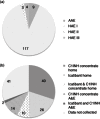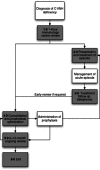In pursuit of excellence: an integrated care pathway for C1 inhibitor deficiency
- PMID: 23607500
- PMCID: PMC3694529
- DOI: 10.1111/cei.12083
In pursuit of excellence: an integrated care pathway for C1 inhibitor deficiency
Abstract
There are estimated to be approximately 1500 people in the United Kingdom with C1 inhibitor (C1INH) deficiency. At BartsHealth National Health Service (NHS) Trust we manage 133 patients with this condition and we believe that this represents one of the largest cohorts in the United Kingdom. C1INH deficiency may be hereditary or acquired. It is characterized by unpredictable episodic swellings, which may affect any part of the body, but are potentially fatal if they involve the larynx and cause significant morbidity if they involve the viscera. The last few years have seen a revolution in the treatment options that are available for C1 inhibitor deficiency. However, this occurs at a time when there are increased spending restraints in the NHS and the commissioning structure is being overhauled. Integrated care pathways (ICP) are a tool for disseminating best practice, for facilitating clinical audit, enabling multi-disciplinary working and for reducing health-care costs. Here we present an ICP for managing C1 inhibitor deficiency.
© 2013 Crown Copyright. This article is published with the permission of the Controller of HMSO and the Queen's Printer for Scotland.
Figures


Similar articles
-
New therapeutics in C1INH deficiency: a review of recent studies and advances.Curr Allergy Asthma Rep. 2011 Aug;11(4):300-8. doi: 10.1007/s11882-011-0203-x. Curr Allergy Asthma Rep. 2011. PMID: 21607669 Review.
-
Angioedema triggered by pulp extirpation--a case report.Oral Maxillofac Surg. 2011 Dec;15(4):253-5. doi: 10.1007/s10006-010-0249-2. Epub 2010 Oct 22. Oral Maxillofac Surg. 2011. PMID: 20967560
-
Overview of hereditary angioedema caused by C1-inhibitor deficiency: assessment and clinical management.Eur Ann Allergy Clin Immunol. 2013 Feb;45(1):7-16. Eur Ann Allergy Clin Immunol. 2013. PMID: 23678554 Review.
-
[Update in hereditary angioedema due to C1 inhibitor deficiency].Med Clin (Barc). 2012 Oct 20;139(10):452-7. doi: 10.1016/j.medcli.2012.03.024. Epub 2012 Jun 5. Med Clin (Barc). 2012. PMID: 22677048 Spanish. No abstract available.
-
Efficacy of on-demand treatment in reducing morbidity in patients with hereditary angioedema due to C1 inhibitor deficiency.Allergy. 2015 Dec;70(12):1553-8. doi: 10.1111/all.12731. Epub 2015 Sep 30. Allergy. 2015. PMID: 26304015
Cited by
-
C1 inhibitor deficiency: 2014 United Kingdom consensus document.Clin Exp Immunol. 2015 Jun;180(3):475-83. doi: 10.1111/cei.12584. Epub 2015 May 13. Clin Exp Immunol. 2015. PMID: 25605519 Free PMC article.
-
Real-world outcomes in hereditary angioedema: first experience from the Icatibant Outcome Survey in the United Kingdom.Allergy Asthma Clin Immunol. 2018 Aug 6;14:28. doi: 10.1186/s13223-018-0253-x. eCollection 2018. Allergy Asthma Clin Immunol. 2018. PMID: 30127805 Free PMC article.
-
The international WAO/EAACI guideline for the management of hereditary angioedema - The 2021 revision and update.World Allergy Organ J. 2022 Apr 7;15(3):100627. doi: 10.1016/j.waojou.2022.100627. eCollection 2022 Mar. World Allergy Organ J. 2022. PMID: 35497649 Free PMC article.
-
Optimum Use of Acute Treatments for Hereditary Angioedema: Evidence-Based Expert Consensus.Front Med (Lausanne). 2018 Mar 12;4:245. doi: 10.3389/fmed.2017.00245. eCollection 2017. Front Med (Lausanne). 2018. PMID: 29594115 Free PMC article. Review.
-
Disease Severity, Activity, Impact, and Control and How to Assess Them in Patients with Hereditary Angioedema.Front Med (Lausanne). 2017 Dec 4;4:212. doi: 10.3389/fmed.2017.00212. eCollection 2017. Front Med (Lausanne). 2017. PMID: 29255709 Free PMC article. Review.
References
-
- Bygum A. Hereditary angio-oedema in Denmark: a nationwide survey. Br J Dermatol. 2009;161:1153–1158. - PubMed
-
- Roche O, Blanch A, Caballero T, Sastre N, Callejo D, Lopez-Trascasa M. Hereditary angioedema due to C1 inhibitor deficiency: patient registry and approach to the prevalence in Spain. Ann Allergy Asthma Immunol. 2005;94:498–503. - PubMed
-
- Agostoni A, Cicardi M. Hereditary and acquired C1-inhibitor deficiency: biological and clinical characteristics in 235 patients. Medicine. 1992;71:206–215. - PubMed
-
- Bork K, Hardt J, Schicketanz KH, Ressel N. Clinical studies of sudden upper airway obstruction in patients with hereditary angioedema due to C1 esterase inhibitor deficiency. Arch Intern Med. 2003;163:1229–1235. - PubMed
-
- Bork K, Siedlecki K, Bosch S, Schopf RE, Kreuz W. Asphyxiation by laryngeal edema in patients with hereditary angioedema. Mayo Clin Proc. 2000;75:349–354. - PubMed
Publication types
MeSH terms
Substances
LinkOut - more resources
Full Text Sources
Other Literature Sources
Miscellaneous

